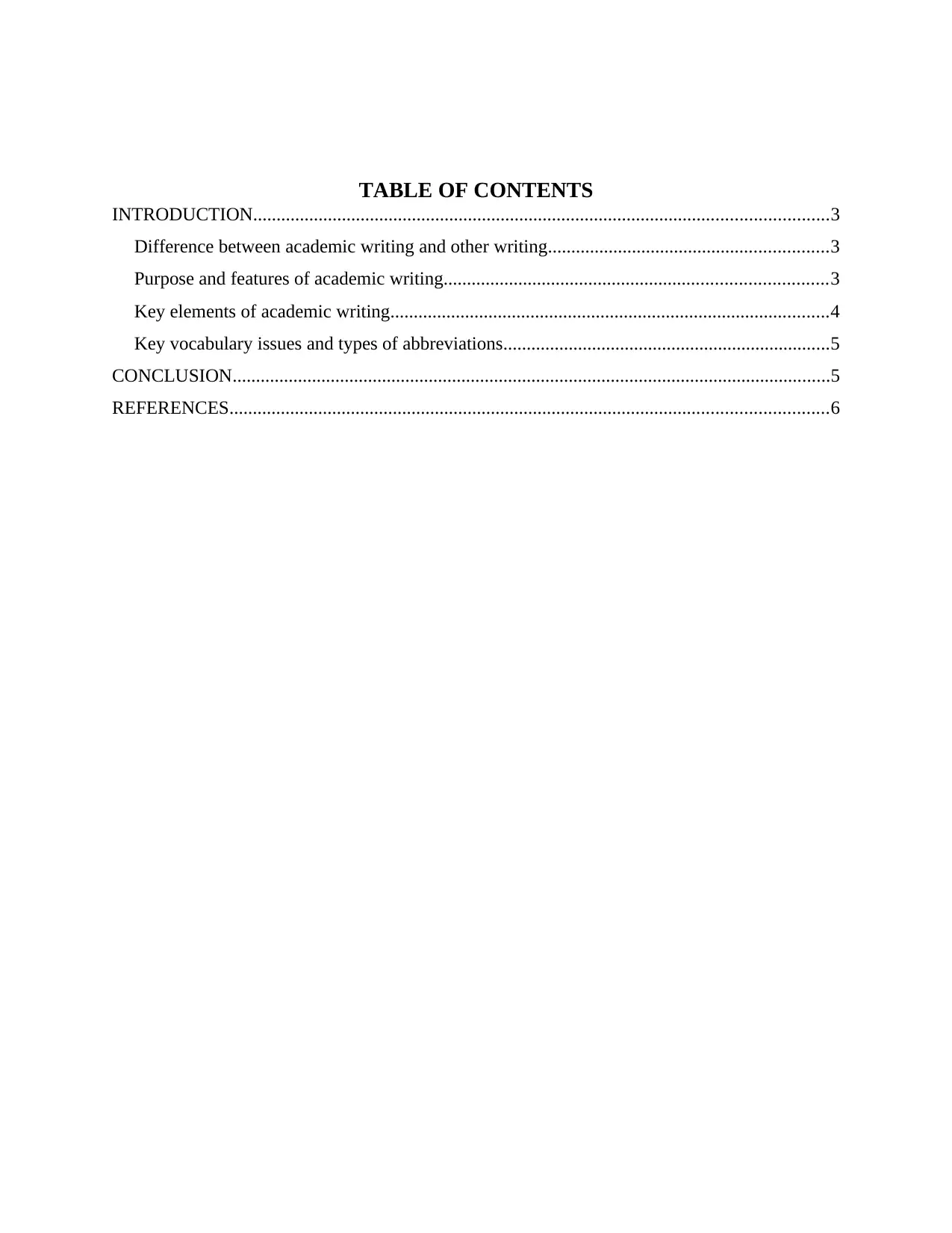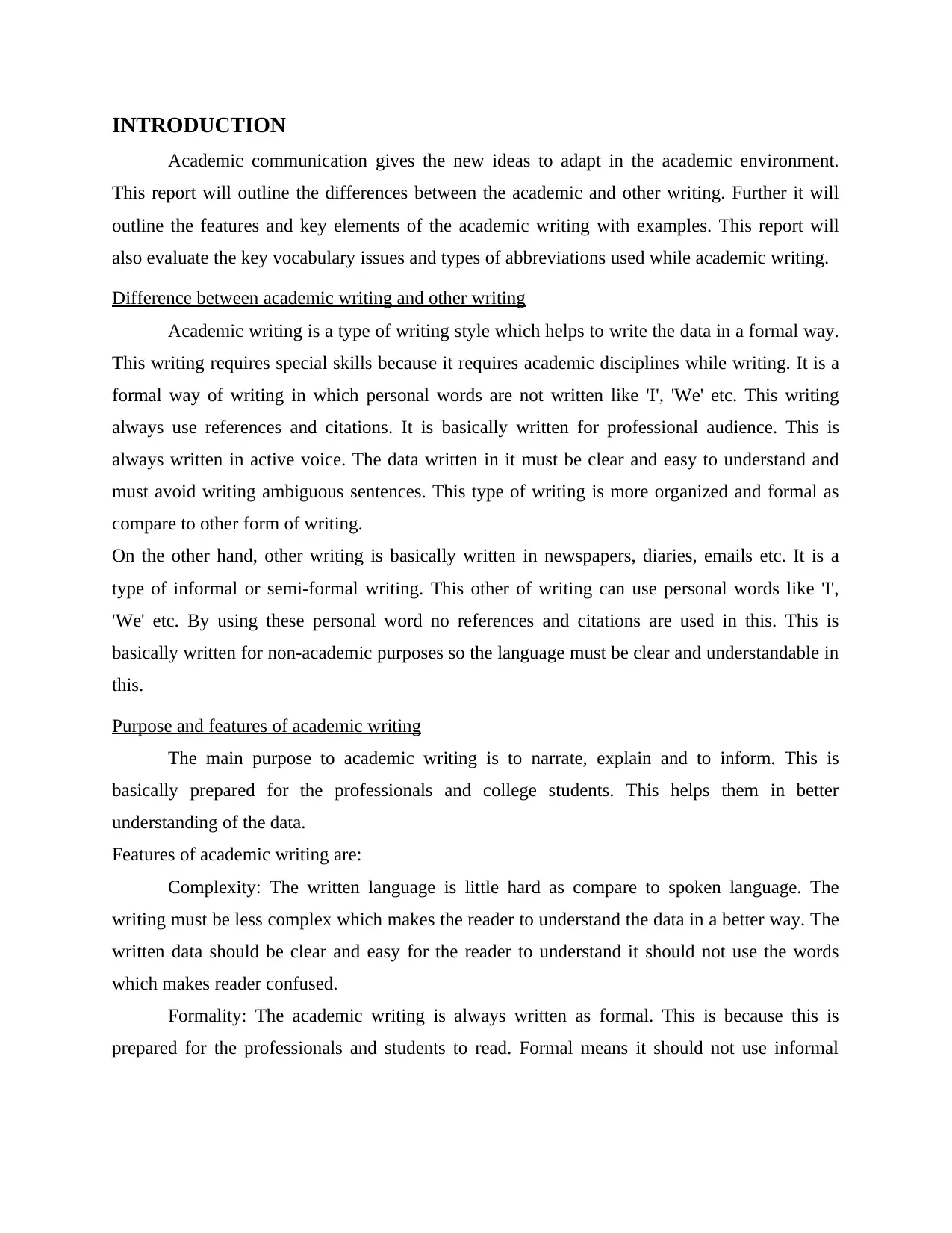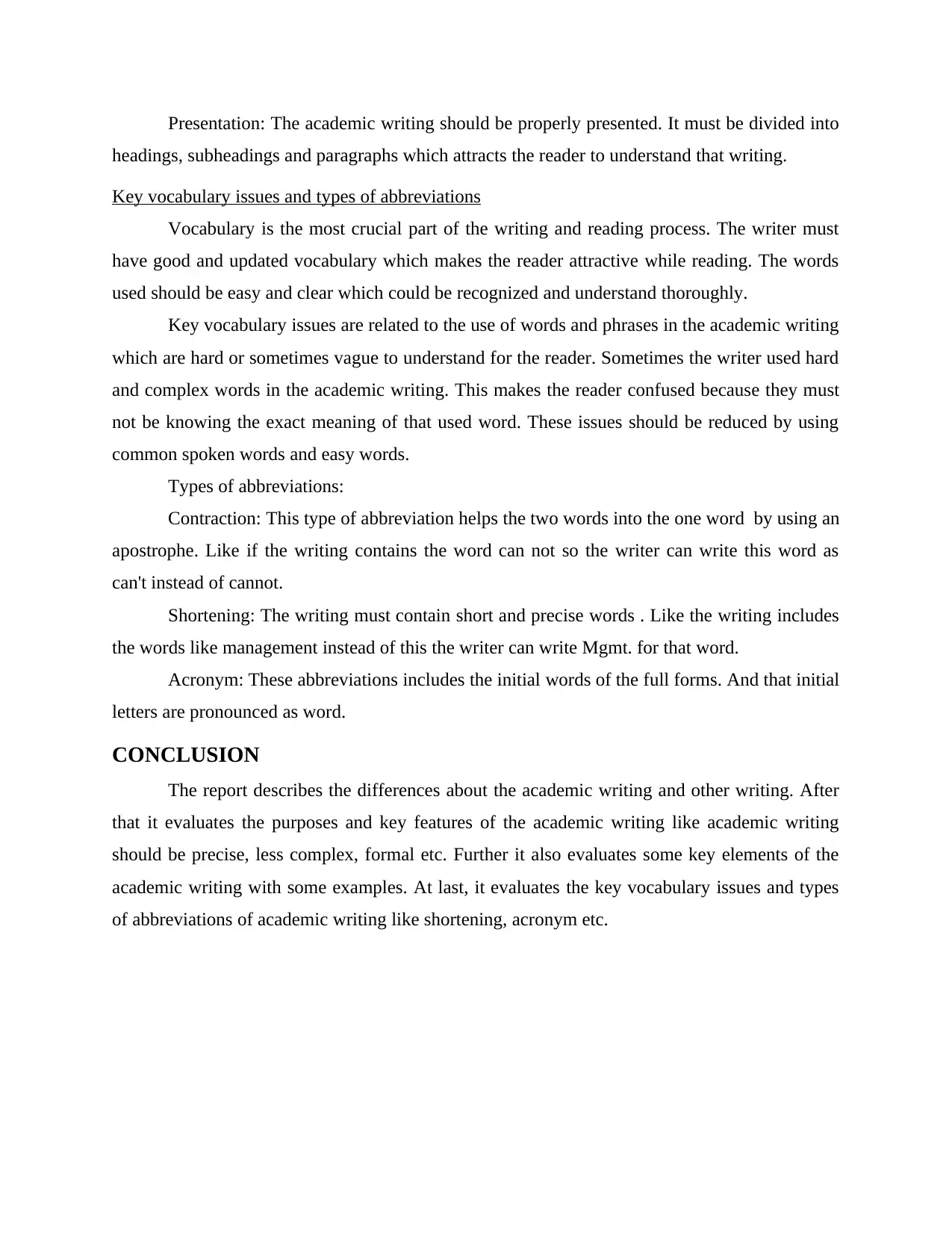Developing Academic Communication Skills for Professional Success
VerifiedAdded on 2023/06/18
|8
|1415
|338
Report
AI Summary
This report provides a comprehensive overview of developing academic communication skills, highlighting the differences between academic writing and other forms of writing. It delves into the purpose and key features of academic writing, such as complexity, formality, precision, and conciseness. The report also outlines essential elements like thesis development, motive, analysis, structure, key terms, and presentation. Furthermore, it addresses key vocabulary issues and various types of abbreviations used in academic writing, including contractions, shortening, and acronyms. The report concludes by summarizing the importance of these aspects in enhancing effective academic communication, supported by relevant references.

Developing Academic
Communication Skills
Communication Skills
Paraphrase This Document
Need a fresh take? Get an instant paraphrase of this document with our AI Paraphraser

TABLE OF CONTENTS
INTRODUCTION...........................................................................................................................3
Difference between academic writing and other writing............................................................3
Purpose and features of academic writing..................................................................................3
Key elements of academic writing..............................................................................................4
Key vocabulary issues and types of abbreviations......................................................................5
CONCLUSION................................................................................................................................5
REFERENCES................................................................................................................................6
INTRODUCTION...........................................................................................................................3
Difference between academic writing and other writing............................................................3
Purpose and features of academic writing..................................................................................3
Key elements of academic writing..............................................................................................4
Key vocabulary issues and types of abbreviations......................................................................5
CONCLUSION................................................................................................................................5
REFERENCES................................................................................................................................6

INTRODUCTION
Academic communication gives the new ideas to adapt in the academic environment.
This report will outline the differences between the academic and other writing. Further it will
outline the features and key elements of the academic writing with examples. This report will
also evaluate the key vocabulary issues and types of abbreviations used while academic writing.
Difference between academic writing and other writing
Academic writing is a type of writing style which helps to write the data in a formal way.
This writing requires special skills because it requires academic disciplines while writing. It is a
formal way of writing in which personal words are not written like 'I', 'We' etc. This writing
always use references and citations. It is basically written for professional audience. This is
always written in active voice. The data written in it must be clear and easy to understand and
must avoid writing ambiguous sentences. This type of writing is more organized and formal as
compare to other form of writing.
On the other hand, other writing is basically written in newspapers, diaries, emails etc. It is a
type of informal or semi-formal writing. This other of writing can use personal words like 'I',
'We' etc. By using these personal word no references and citations are used in this. This is
basically written for non-academic purposes so the language must be clear and understandable in
this.
Purpose and features of academic writing
The main purpose to academic writing is to narrate, explain and to inform. This is
basically prepared for the professionals and college students. This helps them in better
understanding of the data.
Features of academic writing are:
Complexity: The written language is little hard as compare to spoken language. The
writing must be less complex which makes the reader to understand the data in a better way. The
written data should be clear and easy for the reader to understand it should not use the words
which makes reader confused.
Formality: The academic writing is always written as formal. This is because this is
prepared for the professionals and students to read. Formal means it should not use informal
Academic communication gives the new ideas to adapt in the academic environment.
This report will outline the differences between the academic and other writing. Further it will
outline the features and key elements of the academic writing with examples. This report will
also evaluate the key vocabulary issues and types of abbreviations used while academic writing.
Difference between academic writing and other writing
Academic writing is a type of writing style which helps to write the data in a formal way.
This writing requires special skills because it requires academic disciplines while writing. It is a
formal way of writing in which personal words are not written like 'I', 'We' etc. This writing
always use references and citations. It is basically written for professional audience. This is
always written in active voice. The data written in it must be clear and easy to understand and
must avoid writing ambiguous sentences. This type of writing is more organized and formal as
compare to other form of writing.
On the other hand, other writing is basically written in newspapers, diaries, emails etc. It is a
type of informal or semi-formal writing. This other of writing can use personal words like 'I',
'We' etc. By using these personal word no references and citations are used in this. This is
basically written for non-academic purposes so the language must be clear and understandable in
this.
Purpose and features of academic writing
The main purpose to academic writing is to narrate, explain and to inform. This is
basically prepared for the professionals and college students. This helps them in better
understanding of the data.
Features of academic writing are:
Complexity: The written language is little hard as compare to spoken language. The
writing must be less complex which makes the reader to understand the data in a better way. The
written data should be clear and easy for the reader to understand it should not use the words
which makes reader confused.
Formality: The academic writing is always written as formal. This is because this is
prepared for the professionals and students to read. Formal means it should not use informal
⊘ This is a preview!⊘
Do you want full access?
Subscribe today to unlock all pages.

Trusted by 1+ million students worldwide

words or personal words which makes the writing biased. The formal writing should be proper
planned and structured.
Precision: The writing should always be precise as long writing makes the reader bored
and confused. The academic writing shall contain the key points which attracts the reader to read
that writing. If the writer is not confirmed about some words than they must confirm its meaning
and then use that word. Hard words and confused words should be avoided while academic
writing.
Conciseness: The data written for academics should be written concisely. The writer must
avoid writing the same sentences again in the writing. They should also use the proper and
meaningful words. Writing must contain the commonly speaking words rather than using hard
and complex words.
Key elements of academic writing
The most important key elements of academic writing are:
Thesis: In this element the writer can add the idea or introduction about the topic and the key
points on which the data is evaluated. For example, if the writer is writing on communication
topic than they must write some of his ideas which is required for reader to understand it easily.
Motive: The writing must be made for some purpose and motive. It is basically prepared
for the projects of professionals and college students. For example, the writer must have some
motives like they must be having lecture programme, so they can prepare the academic writing
for that programme.
Analysis: The matter contained in that writing should be properly analysed by the writer
after the completion of writing. It makes the reader easier to understand the data. There should
not be any mistakes contained which makes the data vague.
Structured: The writing must be properly organized and structured. It should contain the
introduction of the topic, proper body of the topic and summary. For example, if the person is
preparing academic writing on the communication topic than he must write introduction, main
body and summary related to the communication.
Key terms: The writing must contained the key points of the whole. It makes the reader
easily understand that writing. For example, the writer must write the key points of the
communication topic which will make the reader understand it easily.
planned and structured.
Precision: The writing should always be precise as long writing makes the reader bored
and confused. The academic writing shall contain the key points which attracts the reader to read
that writing. If the writer is not confirmed about some words than they must confirm its meaning
and then use that word. Hard words and confused words should be avoided while academic
writing.
Conciseness: The data written for academics should be written concisely. The writer must
avoid writing the same sentences again in the writing. They should also use the proper and
meaningful words. Writing must contain the commonly speaking words rather than using hard
and complex words.
Key elements of academic writing
The most important key elements of academic writing are:
Thesis: In this element the writer can add the idea or introduction about the topic and the key
points on which the data is evaluated. For example, if the writer is writing on communication
topic than they must write some of his ideas which is required for reader to understand it easily.
Motive: The writing must be made for some purpose and motive. It is basically prepared
for the projects of professionals and college students. For example, the writer must have some
motives like they must be having lecture programme, so they can prepare the academic writing
for that programme.
Analysis: The matter contained in that writing should be properly analysed by the writer
after the completion of writing. It makes the reader easier to understand the data. There should
not be any mistakes contained which makes the data vague.
Structured: The writing must be properly organized and structured. It should contain the
introduction of the topic, proper body of the topic and summary. For example, if the person is
preparing academic writing on the communication topic than he must write introduction, main
body and summary related to the communication.
Key terms: The writing must contained the key points of the whole. It makes the reader
easily understand that writing. For example, the writer must write the key points of the
communication topic which will make the reader understand it easily.
Paraphrase This Document
Need a fresh take? Get an instant paraphrase of this document with our AI Paraphraser

Presentation: The academic writing should be properly presented. It must be divided into
headings, subheadings and paragraphs which attracts the reader to understand that writing.
Key vocabulary issues and types of abbreviations
Vocabulary is the most crucial part of the writing and reading process. The writer must
have good and updated vocabulary which makes the reader attractive while reading. The words
used should be easy and clear which could be recognized and understand thoroughly.
Key vocabulary issues are related to the use of words and phrases in the academic writing
which are hard or sometimes vague to understand for the reader. Sometimes the writer used hard
and complex words in the academic writing. This makes the reader confused because they must
not be knowing the exact meaning of that used word. These issues should be reduced by using
common spoken words and easy words.
Types of abbreviations:
Contraction: This type of abbreviation helps the two words into the one word by using an
apostrophe. Like if the writing contains the word can not so the writer can write this word as
can't instead of cannot.
Shortening: The writing must contain short and precise words . Like the writing includes
the words like management instead of this the writer can write Mgmt. for that word.
Acronym: These abbreviations includes the initial words of the full forms. And that initial
letters are pronounced as word.
CONCLUSION
The report describes the differences about the academic writing and other writing. After
that it evaluates the purposes and key features of the academic writing like academic writing
should be precise, less complex, formal etc. Further it also evaluates some key elements of the
academic writing with some examples. At last, it evaluates the key vocabulary issues and types
of abbreviations of academic writing like shortening, acronym etc.
headings, subheadings and paragraphs which attracts the reader to understand that writing.
Key vocabulary issues and types of abbreviations
Vocabulary is the most crucial part of the writing and reading process. The writer must
have good and updated vocabulary which makes the reader attractive while reading. The words
used should be easy and clear which could be recognized and understand thoroughly.
Key vocabulary issues are related to the use of words and phrases in the academic writing
which are hard or sometimes vague to understand for the reader. Sometimes the writer used hard
and complex words in the academic writing. This makes the reader confused because they must
not be knowing the exact meaning of that used word. These issues should be reduced by using
common spoken words and easy words.
Types of abbreviations:
Contraction: This type of abbreviation helps the two words into the one word by using an
apostrophe. Like if the writing contains the word can not so the writer can write this word as
can't instead of cannot.
Shortening: The writing must contain short and precise words . Like the writing includes
the words like management instead of this the writer can write Mgmt. for that word.
Acronym: These abbreviations includes the initial words of the full forms. And that initial
letters are pronounced as word.
CONCLUSION
The report describes the differences about the academic writing and other writing. After
that it evaluates the purposes and key features of the academic writing like academic writing
should be precise, less complex, formal etc. Further it also evaluates some key elements of the
academic writing with some examples. At last, it evaluates the key vocabulary issues and types
of abbreviations of academic writing like shortening, acronym etc.

REFERENCES
Books and journals
Ansarifar, A., Shahriari, H. and Pishghadam, R., 2018. Phrasal complexity in academic writing:
A comparison of abstracts written by graduate students and expert writers in applied
linguistics. Journal of English for Academic Purposes. 31. pp.58-71.
Lee, S. M. and Briggs, N., 2021. Effects of using machine translation to mediate the revision
process of Korean university students’ academic writing. ReCALL. 33(1). pp.18-33.
Malmström, H., Pecorari, D. and Shaw, P., 2018. Words for what? Contrasting university
students' receptive and productive academic vocabulary needs. English for Specific
Purposes. 50. pp.28-39.
MUŞLU, M., 2018. Use of stance lexical bundles by Turkish and Japanese EFL learners and
native English speakers in academic writing. Gaziantep University Journal of Social
Sciences. 17(4). pp.1319-1336.
Strobl, C. and et.al., 2019. Digital support for academic writing: A review of technologies and
pedagogies. Computers & Education. 131. pp.33-48.
Wingate, U., 2019. ‘Can you talk me through your argument’? Features of dialogic interaction in
academic writing tutorials. Journal of English for Academic Purposes. 38. pp.25-35.
Books and journals
Ansarifar, A., Shahriari, H. and Pishghadam, R., 2018. Phrasal complexity in academic writing:
A comparison of abstracts written by graduate students and expert writers in applied
linguistics. Journal of English for Academic Purposes. 31. pp.58-71.
Lee, S. M. and Briggs, N., 2021. Effects of using machine translation to mediate the revision
process of Korean university students’ academic writing. ReCALL. 33(1). pp.18-33.
Malmström, H., Pecorari, D. and Shaw, P., 2018. Words for what? Contrasting university
students' receptive and productive academic vocabulary needs. English for Specific
Purposes. 50. pp.28-39.
MUŞLU, M., 2018. Use of stance lexical bundles by Turkish and Japanese EFL learners and
native English speakers in academic writing. Gaziantep University Journal of Social
Sciences. 17(4). pp.1319-1336.
Strobl, C. and et.al., 2019. Digital support for academic writing: A review of technologies and
pedagogies. Computers & Education. 131. pp.33-48.
Wingate, U., 2019. ‘Can you talk me through your argument’? Features of dialogic interaction in
academic writing tutorials. Journal of English for Academic Purposes. 38. pp.25-35.
⊘ This is a preview!⊘
Do you want full access?
Subscribe today to unlock all pages.

Trusted by 1+ million students worldwide

Paraphrase This Document
Need a fresh take? Get an instant paraphrase of this document with our AI Paraphraser

1 out of 8
Related Documents
Your All-in-One AI-Powered Toolkit for Academic Success.
+13062052269
info@desklib.com
Available 24*7 on WhatsApp / Email
![[object Object]](/_next/static/media/star-bottom.7253800d.svg)
Unlock your academic potential
Copyright © 2020–2025 A2Z Services. All Rights Reserved. Developed and managed by ZUCOL.


